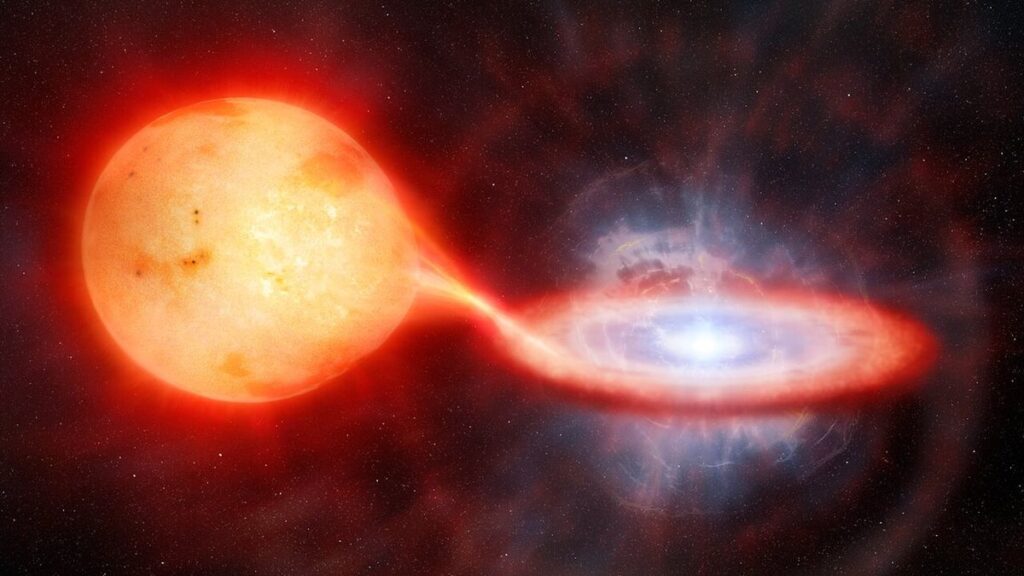Groundbreaking observations of a repeating explosion in space, the recurrent nova LMCN 1968-12a, reveal that it’s the hottest burst of its kind ever recorded.
Located in the Large Magellanic Cloud, a nearby satellite galaxy of the Milky Way, LMCN 1968-12a is the first recurrent nova outside our galaxy to have been studied in near-infrared light.
Beyond its extreme temperatures, this nova is also notable for being an extremely violent eruption with unique chemical properties that differ significantly from those observed in our galaxy, the researchers explained in a paper published in the journal Monthly Notices of the Royal Astronomical Society.
Seeing dead stars
When a white dwarf, the leftover core of a collapsed star, is in a tight orbit around another star, it can pull material from that star, leading to some pretty dramatic astronomical events. One of these is called a nova, which means “new” in Latin.
This event results in a bright flash in the sky, as if a new star had appeared, and lasts a few weeks or months before fading. When the dust clears, the original stars remain (unlike in a supernova, which happens when a star is completely destroyed).
In the binary system, as the white dwarf steals gas from its younger companion, the accumulated material forms an accretion disk around the white dwarf. Matter swirls in the disk, and when it reaches the white dwarf’s surface and piles up, the pressure and temperature rise so high that it ignites a rapid burning of hydrogen into heavier elements. This is known as a thermonuclear runaway reaction.
Related: Scientists find evidence of ‘supernova graveyard’ at the bottom of the sea — and possibly on the surface of the moon
This reaction produces a high-energy blast that expels a huge chunk of material from the white dwarf’s surface — resulting in a nova. The nova is called “recurrent” when the white dwarf continues to pull more material from its companion, causing similar short-lived bursts of energy at regular intervals ranging from a few months to several years apart.
Not many recurrent novas have been observed in our galaxy, and even fewer have been found outside the Milky Way. Studying novas helps astronomers understand the dynamics of binary systems and the influence of surrounding conditions on these eruptions.
LMCN 1968-12a was the first recurrent nova to be found outside our galaxy. Discovered in 1968, the system consists of a white dwarf and a red subgiant star. It erupts every four years, and its eruptions have been observed regularly since 1990.
The most recent eruption occurred in August 2024. Following the initial observations, the Magellan Baade telescope and the Gemini South telescope — both in Chile — carried out follow-up observations of LMCN 1968-12a in near-infrared light nine days and 22 days after the outburst, respectively. The observations showed the light emitted by various elements that became highly energized during the eruption.

Reading the missing lines
The spectra from the Magellan telescope revealed a clear spike in ionized silicon that was 95 times brighter than the light emitted by the sun added up across all of its wavelengths. A similar dominance of silicon was seen in the spectra from Gemini, although the brightness was lower.
The brightness of silicon was unexpected, said study co-author Tom Geballe, an astronomer emeritus at NOIRLab, and the missing spikes were even more surprising.
“We would’ve expected to also see signatures of highly energized sulfur, phosphorus, calcium and aluminum,” Geballe said in a statement.
Study co-author Sumner Starrfield, Regents professor of astrophysics at Arizona State University, added, “This surprising absence, combined with the presence and great strength of the silicon signature, implied an unusually high gas temperature, which our modeling confirmed.”
According to the team’s estimates, this is one of the hottest novas ever recorded, with the temperature of the expelled gas reaching 5.4 million degrees Fahrenheit (3 million degrees Celsius). The highly violent eruption, indicated by such extreme temperatures, suggests a connection to the conditions surrounding the nova.
The Large Magellanic Cloud has a lower metallicity than our galaxy, meaning it contains fewer elements heavier than hydrogen and helium. This results in a greater buildup of matter on the white dwarf’s surface before ignition, leading to more violent nova explosions.
By contrast, in high-metallicity systems, heavy elements alter the process. Moreover, the ejected gas collides with the companion star’s atmosphere, creating a shock that raises temperatures.
Starrfield predicted that low-metallicity material would cause more-intense nova events, and the observations have come through. The study authors emphasized that using large telescopes like Gemini South to study different galaxies will enhance our understanding of these processes in various chemical environments.
